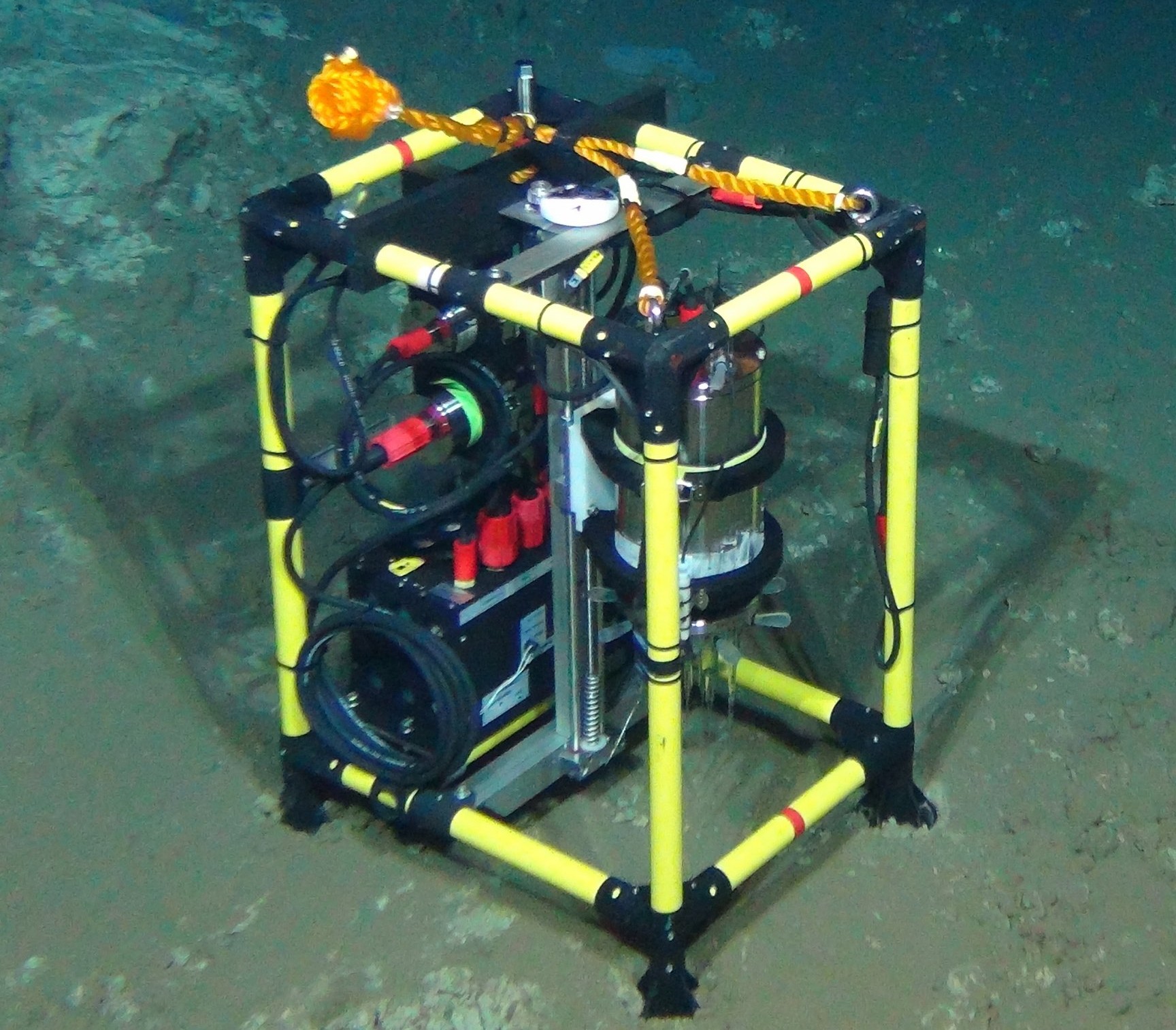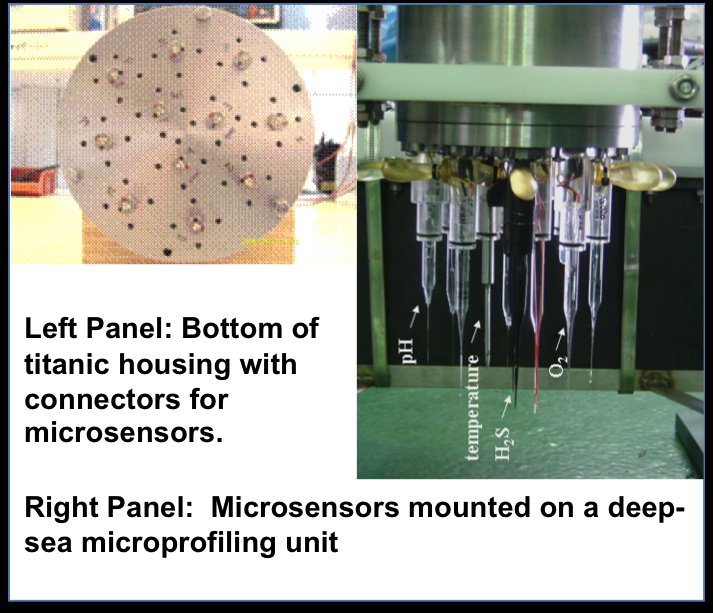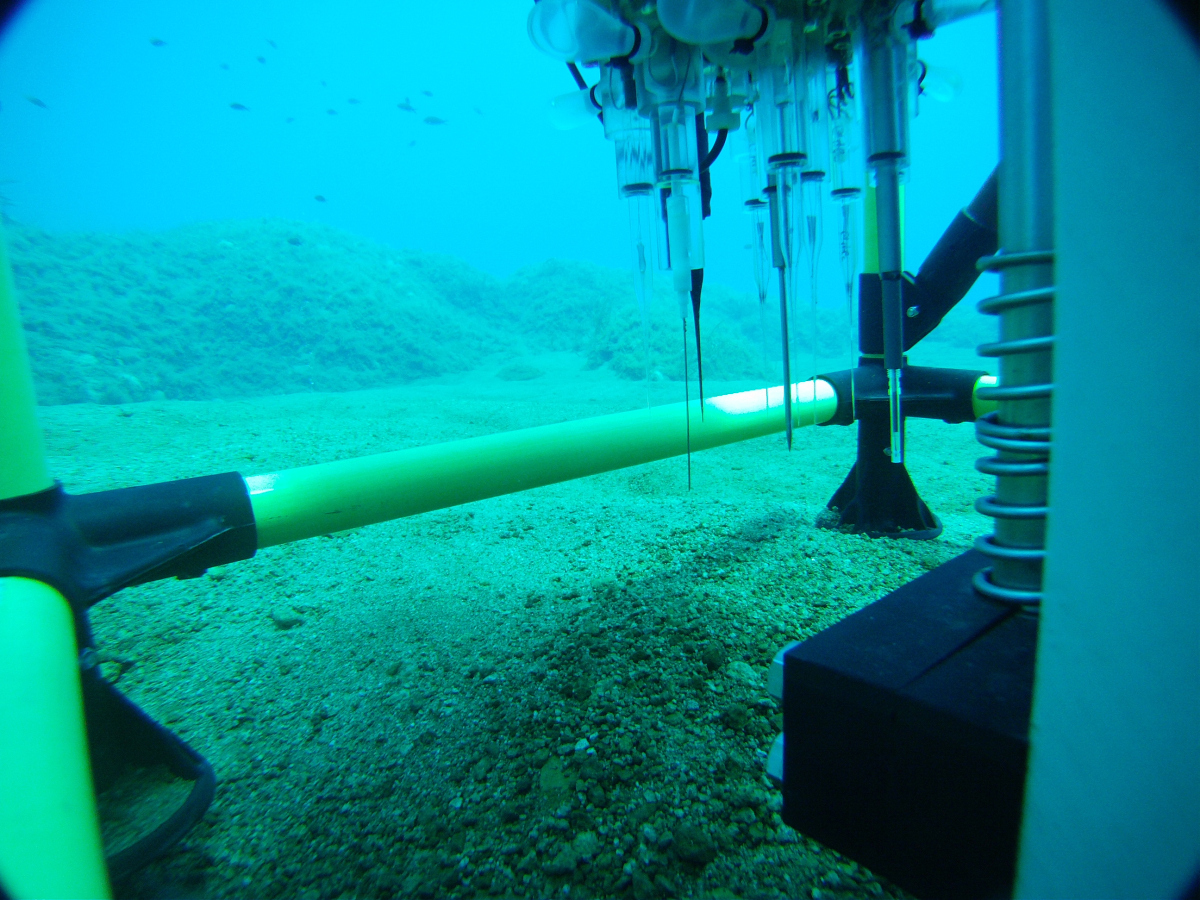Microprofiler
What can the microprofiler do?
The microprofiler is built for use on the seafloor. There, the device measures the geochemistry of the water and the seafloor. For example, the concentration of oxygen, sulphur, or calcium. It also measures parameters such as the pH value and the temperature. The microprofiler collects data via microsensors that it carefully inserts into the seafloor. The device thus works non-invasively and does not take water or floor samples.
The surface of the seafloor is characterized by steep slopes and wide expanses. There are rocky landscapes and endless sandy deserts. The seafloor also changes over time and thus varies greatly not only spatially but also temporally. In order to understand the development of microbial communities, the interplay with their environment, and the various material flows on the seafloor, it is essential to be able to collect accurate data. The activity of microbes on the seafloor varies greatly. For example, it depends on how many micro-organisms there are, how fast they multiply, what pH value and temperature the water has, and what substances are present as food or energy sources.
In order to find out how the micro-organisms live in the sediment and what external influences they follow, their direct habitat must be characterized. To do this, the microprofiler creates a profile of the seafloor that is as accurate as possible (hence the name of the device). For example, the geochemical composition of the immediate environment of the microbes is measured. It is particularly important to find out how this chemical composition changes over time and how much food the microbes have available (e.g. how much oxygen, nitrogen, or even sulphur there is available). These data can then be used to determine the activities of the micro-organisms.
The microprofiler measures this data on site and does not remove samples. It is therefore particularly important to use the device in environments that would be greatly altered by pulling a drill core (e.g. in cold gas leaks or in the deep sea).
Structure of the microprofiler
The microprofiler consists of a titanium housing with sensors and data collection, a motor, a deep-sea battery, and a frame. The sensors are attached to the bottom of the device and are mostly microsensors (i.e. small, needle-shaped and highly sensitive electrodes that can collect geochemical data in the water or seafloor). The tips of the microsensors are 5–50 µm and can thus take non-invasive measurements.
An individually compiled assortment of up to 11 microsensors with an area of 180 cm2 can be used on the device. Autonomous measurement can be carried out with a spatial resolution of up to 50 µm and a maximum depth of 20 cm into the seafloor. Microsensors for oxygen (O2), hydrogen sulphide (H2S), pH, redox reactions, calcium (Ca2+), carbon dioxide partial pressure (pCO2), and nitrate (NO3−) as well as macrosensors for temperature and conductivity are currently available for use in the sea. For example, oxygen consumption rates in deep-sea sediments and sulphide production or consumption in cold sources can be calculated from the measurements.
The microprofiler can be attached to any transport device that takes it to the sampling site. By using remotely operated underwater vehicles (ROVs) and submersibles to implement targeted and precise positioning at selected locations under visual control, it is possible to carry out several measurements at different locations during one dive. The microprofiler can also be mounted on free-falling landers. The device can also be mounted on underwater crawlers for extensive investigations on the seafloor. The latest development, the x-y-z profiler, enables intensive investigations of the seafloor over an area of up to 625 cm2.
The microprofiler in action
The microprofiler is used, for example, in the JPIO project MiningImpact2 “Environmental impacts and risks of deep-sea mining” as well as in the project BENTHIMPACT “Effects of manganese nodule mining on benthic megafauna and microbial communities and their functions”.
As part of these research projects, scientists frequently travel to the DISCOL area in the tropical East Pacific – about 3000 km off the coast of Peru. In 1989, German researchers ploughed up the seafloor of a manganese nodule area at a water depth of 4000 m over an area with a diameter of more than 3.5 km with a harrow in order to simulate mining. For example, on a 2015 expedition (Expedition SO242), it was investigated whether and how the abundance, diversity, and density of micro-organisms in the area have changed in the long term. The focus was also on what the disturbance means in the long term for the carbon cycle and food web of this habitat. The microprofiler was used as part of these investigations and provided valuable geochemical data. For example, it was shown that after 26 years, the biogeochemical conditions in the DISCOL area have been sustainably altered.
Another expedition to the DISCOL area took place in 2018. Once again, the microprofiler was on board. It also travelled with the device to the Clarion-Clipperton Zone in the Eastern Pacific in 2019. It will be used there again in 2021.
Results of the SO242 expedition can be read here:
- Vonnahme T.R., Molari M., Janssen F., Wenzhöfer F., Haeckel M., Titschack T., Boetius A. (2020) Effects of a deep-sea mining experiment on seafloor microbial communities and functions after 26 years. Science Advances. DOI: 10.1126/sciadv.aaz5922
- Daniëlle S.W. de Jonge, Tanja Stratmann, Lidia Lins, Ann Vanreusel, Autun Purser, Yann Marcon, Clara F. Rodrigues, Ascensão Ravara, Patricia Esquete, Marina R. Cunha, Erik Simon-Lledó, Peter van Breugel, Andrew K. Sweetman, Karline Soetaert, Dick van Oevelen (2020): Abyssal food-web model indicates faunal carbon flow recovery and impaired microbial loop 26 years after a sediment disturbance experiment, Progress in Oceanography, October 2020. DOI:1016/j.pocean.2020.102446
Or also in press releases:
Technical details
Number of sensors: 11 (can be arranged individually)
Area covered: 176 cm2
Resolution: Minimum step size for measurements is 50 µm
Duration of measurement: maximum 34 h with a small deep-cell battery
Greatest possible depth of use: 6000 m
Who uses the microprofiler?
The microprofiler is mainly used by members of the HGF MPG joint research group for deep-sea ecology and technology and by the Symbiosis Department.
Please direct your queries to
Scientist
HGF MPG Joint Research Group for Deep-Sea Ecology and Technology
MPI for Marine Microbiology
Celsiusstr. 1
D-28359 Bremen
Germany
|
Room: |
1338 |
|
Phone: |

Scientist
HGF MPG Joint Research Group for Deep-Sea Ecology and Technology
MPI for Marine Microbiology
Celsiusstr. 1
D-28359 Bremen
Germany
|
Room: |
1337 |
|
Phone: |




